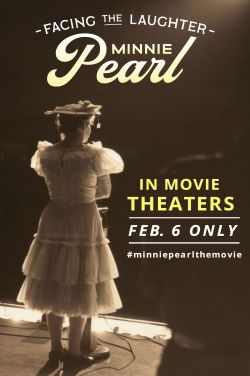By Jordan Green, Editor-in-Chief
People far and wide still know the laughter, wide smile and southern drawl of Minnie Pearl, who began her comedy acts with a long, “Hooowww-deee! I’m just so proud to be here!”
Minnie Pearl was one of the most legendary comics of the 20th century, and her story is retold in a new full-length documentary, “Facing the Laughter: Minnie Pearl.”
My family and I were fortunate enough to catch a glimpse of this tremendous 90-minute production when it appeared in theaters Feb. 6.
It was only available for one day, though it will be available on various streaming platforms.
Through a series of interviews with entertainers from virtually all walks of life, one gets the idea that Minnie Pearl – whose real name was Sarah Cannon – had quite an impact on the lives of her audience and her friends.
Country music stars such as Garth Brooks, Brenda Lee and Bill Anderson, among others, had time to share their personal stories of Minnie Pearl and her infectious sense of humor.
The documentary also highlighted how she overcame adversity in the entertainment realm at a time when women didn’t have an easy road to fame.
Through effective uses of flashbacks and clips of her performances, the documentary cuts through the noise and paints a picture of who Minnie Pearl truly was: honest, humble and loving.
It highlights not only some of her funniest moments, but it also shows clips of other entertainers mimicking her through the years, a testament to her persona’s wide appeal and renown.
The documentary did an excellent job of showing how the Minnie Pearl people saw on stage was the same person off stage.
Her heart was always pure and true.

One of the most unique forms of storytelling incorporated in the documentary was the use of Minnie Pearl’s voice recordings in which she read what seemed like her personal journals.
Whenever these recordings were used, shots of a working vintage tape player were shown as tape passed from one reel to another.
This drew the viewer in to her message, and the use of subtitles clarified any words that yankees might have a hard time understanding.
Of course, the intermittent interviews spliced in between clips of Minnie Pearl’s acts shed a light on her character and soul.
People from all walks of life had a platform to talk about the impact Minnie Pearl had on them and how they still live by the wisdom she shared. Interviews from Amy Grant and others were used effectively, helping the viewer find reassurance that, unlike some celebrities, Minnie Pearl was as good as she seemed.
These interviews had quite an interesting effect, almost as if they were reassuring people that, sometimes, it’s OK to meet your heroes.
Some are even better than we’d hope. Minnie Pearl was a faithful woman, which was duly highlighted in the story.
I have few complaints about the documentary, though I did disdain how the producers and writers took some artistic liberties with how they believe Minnie Pearl would respond to contemporary social controversies.
Rather than spending several minutes opining about what they want to believe Minnie Pearl would do today on social issues, they should have stayed focused on her life, which was extraordinary.
I also found the use of stock footage and sound effects annoying and out of place.
For example, several scenes of cars driving down highways were clearly filmed in the U.K., and in one scene, the producers used the sound of a diesel locomotive horn when showing footage of a steam engine.
Correcting these minor flaws would have enhanced the realistic quality of the production.
Overall, I would give the documentary four out of five stars and recommend that people over the age of 18 give it a watch.
Though it had some minor problems, it was effective at helping preserve the stories that made Minnie Pearl such a dearly beloved and motivational figure for people around the world.
When I got to watch “Facing the Laughter: Minnie Pearl,” I was proud to be there.

